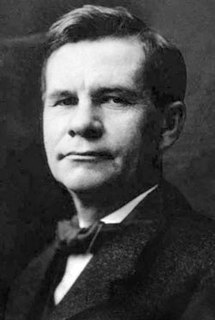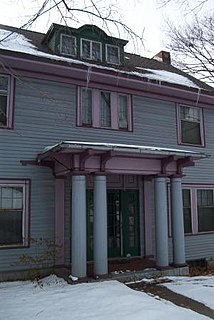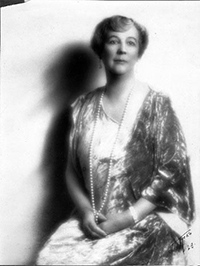Related Research Articles

The Arts and Crafts movement was an international trend in the decorative and fine arts that developed earliest and most fully in the British Isles and subsequently spread across the British Empire and to the rest of Europe and America.
Craftsman may refer to:

Gustav Stickley was an American furniture manufacturer, design leader, publisher, and a leading voice in the American Arts and Crafts movement. Stickley's design philosophy was a major influence on American Craftsman architecture.

American craft is craft work produced by independent studio artists working with traditional craft materials and processes. Examples include wood, glass, clay (ceramics), textiles, and metal (metalworking). Studio craft works tend to either serve or allude to a functional or utilitarian purpose, although they are just as often handled and exhibited in ways similar to visual art objects.

American Craftsman is an American domestic architectural style, inspired by the Arts and Crafts movement, which included interior design, landscape design, applied arts, and decorative arts, beginning in the last years of the 19th century. Its immediate ancestors in American architecture are the Shingle style, which began the move away from Victorian ornamentation toward simpler forms; and the Prairie style of Frank Lloyd Wright. The name "Craftsman" was appropriated from furniture-maker Gustav Stickley, whose magazine The Craftsman was first published in 1901. The architectural style was most widely used in small-to-medium-sized Southern California single-family homes from about 1905, so that the smaller-scale Craftsman style became known alternatively as "California bungalow". The style remained popular into the 1930s, and has continued with revival and restoration projects through present times.

Ward Wellington Ward (1875–1932) was an American architect who worked mostly in Syracuse, New York. He designed more than 250 buildings, of which more than 120 were built and survive. He was influenced by, and contributed to, the Arts and Crafts movement in architecture. Ward's work is in varying styles, but the houses most typically include crafts-like details such as decorative cutouts in shutters. His designs almost always include garages, gateways, and other small structures like gazebos.
Arline Fisch is an American artist and educator. She is known for her work as a metalsmith and jeweler, pioneering the use of textile processes from crochet, knitting, plaiting, and weaving in her work in metal. She developed groundbreaking techniques for incorporating metal wire and other materials into her jewelry.

Craftsman Farms is a historic house located in Parsippany-Troy Hills, Morris County, New Jersey, United States. It was founded by noted early 20th century designer Gustav Stickley as a farm and school for the Arts and Crafts movement. It remained in use until 1915 when it was sold to a family and became a private house.

Harvey Ellis was an architect, perspective renderer, painter and furniture designer. He worked in Rochester, New York; Utica, New York; St. Paul, Minnesota; Minneapolis, Minnesota; St. Joseph, Missouri; St. Louis, Missouri and Syracuse, New York.

The Gustav Stickley House is a three-story wood frame Queen Anne style house in Syracuse, New York. It was originally designed by architect Wellington Tabor and purchased in June 1900 by furniture designer Gustav Stickley. On the outside, it is similar to many other houses on the block and in the neighborhood, not far from Syracuse University. However, the chestnut wall paneling and beamed interior that Stickley designed is regarded as the first comprehensive American Craftsman residential interior in the United States.

The Craftsman was a magazine founded by the American furniture designer Gustav Stickley that championed the American Arts and Crafts movement.

Dame Vera Doreen Blumhardt was a New Zealand potter, ceramicist and arts educator.

Charles Fergus Binns was an English-born studio potter. Binns was the first director of the New York State School of Clayworking and Ceramics, currently called the New York State College of Ceramics at Alfred University. He began his position in 1900 and retired in 1931. His work included authorship of several books on the history and practice of pottery. Some of his more notable students included Arthur Eugene Baggs, William Victor Bragdon, R. Guy Cowan, Maija Grotell and Elizabeth Overbeck. This has led Binns to be called "the father of American studio ceramics".
Cynthia Schira is an American textile artist and former university professor. Her work is represented in the collections of many major public museums.
Janet Payne Bowles was an American art educator, metalsmith, and jewelry designer from Indianapolis, Indiana, who is best known for creating intricate Arts-and-Crafts-style jewelry, flatware, and other small objects. Although the self-taught artisan had little commercial success during her lifetime, she became famous after designing a jewelry collection for actress Maude Adams to wear in a stage production of As You Like It. Sir Caspar Purdon Clarke and J. P. Morgan commissioned Payne Bowles to make severals pieces of metalwork and jewelry for their collections. She also regularly exhibited her art in the United States and Europe and taught art classes at Shortridge High School in Indianapolis from 1912 until her retirement in 1942. Examples of Payne Bowles's work are included in the collections of the Indianapolis Museum of Art. She also wrote book reviews for Modern Art in the early years of her career and contributed articles to The Craftsman in 1904, Handicraft in 1909 and in 1910, and Jewelers' Circular Weekly in 1911. In addition, Payne Bowles provided illumination paintings for limited-edition books such as The Second Epistle of John (1901). Her novel, Gossamer to Steel, was published in 1917.
Eudorah Moore was an American curator and patron of the arts. She is regarded as revolutionizing California design and for her advocacy of craft as an art form.

Theresa Pollak was an American artist and art educator born in Richmond, Virginia. She was a nationally known painter, and she is largely credited with the founding of Virginia Commonwealth University's School of the Arts. She was a teacher at VCU's School of the Arts between 1928 and 1969. Her art has been exhibited in the Whitney Museum of American Art in New York, the Boston Museum of Fine Art, and the Corcoran Gallery in Washington, D.C. She died at the age of 103 on September 18, 2002 and was given a memorial exhibition at Anderson Gallery of Virginia Commonwealth University.

Elizabeth Eaton Burton (1869–1937) was an American artist and designer whose work typified the Arts and Crafts style in southern California.
Irene Bass Sutton Wellington (1904–1984) was an influential British calligrapher and teacher of calligraphy.
Linda Threadgill is an American artist whose primary emphasis is metalsmithing. Her metal work is inspired by forms of nature and the interpretations she gleans from the intricate patterns it presents. She explores the foundation of nature to allude to nature and transform it into re-imagined, stylized plants forms.
References
- 1 2 3 4 5 6 Zipf, Catherine W. Professional Pursuits: Women and the American Arts and Crafts Movement. Knoxville: University of Tennessee Press, 2007, pp. 143–48.
- 1 2 3 "Dr. Sargent, Famed Art Critic, Dies; Was Professor in Syracuse University Fine Arts College 36 Years." Syracuse Herald, Sept. 14, 1932.
- 1 2 3 4 5 6 7 8 9 10 11 12 13 14 15 16 17 Gabriel, Cleota Reed. "Irene Sargent: Rediscovering a Lost Legend". The Courier 16:2 (Summer 1979), pp. 3–13.
- 1 2 3 4 5 6 7 8 9 10 "Irene Sargent Collection". Syracuse University Libraries, Special Collections Research Center.
- ↑ Meikle, Jeffrey L. Design in the USA. Oxford History of Art. Oxford University Press, 2005, p. 85.
- ↑ "Dr. Irene Sargent Is Buried in Presence of 200 Former Students and Associates." Syracuse Post-Standard, Sept. 16, 1932.